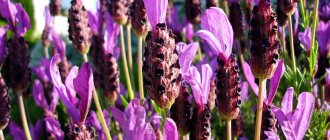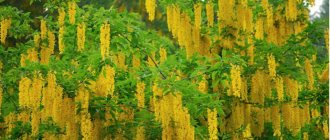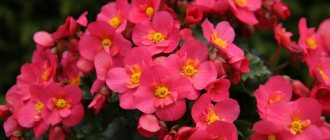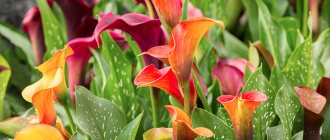This beautiful plant will add elegance to any interior, terrace or garden. At a young age, calla lilies are demanding in care, but then they willingly give exclusive flowers to the gardener. The plant is known not only for this. Its often variegated, large, lush green leaves are an interesting, exotic element even without flowers. It can be used as an apartment decoration as a houseplant, looks good in the garden in spring and summer, and can also be used as a cut flower. This article discusses how to grow garden callas, planting and care in open ground, propagation and use in landscape design.
Description and origin of the plant
Calla is also called calla calla, but its correct name is Zantedeschia.
The flower is called differently in different regions, the following names are known:
- Mother of God's help (common in the Urals).
- Pork bean.
- Wax plant.
- Meadow crustaceans.
- Whitewing.
- Swamp grass.
- Kapelushnik or hat maker.
- Marriage flower.
- Water root.
- Guska.
- Serpentine or snake-grass, snake.
- Frogman.
- Bear paws.
- Cockerels.
- Breadbox or bread bin.
The plant comes from the Araceae family, its natural environment is central and southern Africa. Callas grow in periodically dry and flooded areas - they can survive drought thanks to their rhizomes and revive when there is enough water.
Currently, 8 species of these interesting plants are known; they can be found almost all over the world (except Antarctica). In our country, zantedeschias are used as ornamental plants - mainly for cut flowers and as potted plants, and in spring and summer they can be grown in the garden, on the terrace. Calla lilies owe their popularity to their beautiful, often spotted leaves and spectacular inflorescences, which can be of different colors:
- white,
- yellow,
- orange,
- pink,
- red,
- purple,
- two-color.
The flowering period of calla lilies grown in open ground occurs at the end of summer. But it can be speeded up by growing the plant in pots at home before planting it in the ground.
Geographical distribution
Callas come from Central and Southern Africa (Nigeria, Tanzania, South Africa). Ethiopian zantedeschia was introduced to Europe in the 17th century. Currently, this species is considered naturalized in Europe (in the Azores, Madeira, Iberian Peninsula, Corsica, Balkan Peninsula, and in the UK, Western Europe, North and Central America (Costa Rica, Nicaragua), South America (Ecuador), islands of Oceania, Australia and New Zealand.In many places it is considered a dangerous invasive species, displacing native vegetation.
Morphology
These are medium-sized herbaceous plants, reaching a height of 120 cm.
- The stem is large, thick, underground. From a botanical point of view, the type of underground stem has not been definitively established. Sometimes it is assumed to be a rhizome, sometimes a tuber.
- Root . Roots, whose main function is to hold the plant in the ground, grow from the top of the underground stem. The roots are white, if they come to the surface they become dark green.
- Leaves . _ The plants produce many leaves that persist from late winter to late spring (Ethiopian Zantedeschia and Zantedeschia odorata), from spring to fall (other species), or all year round (Ethiopian Zantedeschia in some habitats). The leaves are oval-heart-shaped, thick, shiny. Petioles vary in length from 15 cm (Rehmann Zantedeschia) to 1.5 m (Ethiopian Zantedeschia). The leaf blades are veined, dark green, sometimes speckled white. The leaves contain hydathodes that mediate fertilization.
- Flowers . _ These are monoecious plants that form several elongated inflorescences - cobs. Female flowers are different from male flowers. Pedicels are usually longer than petioles, inflorescences are higher than leaf level. The inflorescence is narrowed, spirally twisted at the base, with a funnel-shaped opening in the upper part, with a deflected and sometimes pointed top. The number of stamens is 6-10. Pollinated by insects. The length and color of the inflorescence depend on the variety. They usually reach 10-25 cm.
- Fruits . Green or orange berries, ovoid or almost spherical, collected in fruit clusters. The seeds are ovoid, with a longitudinally grooved shell and a large endosperm. They ripen in the European part of Russia at the end of August.
Phytochemical properties
Poisonous plants. All parts of calla lilies contain sharp calcium oxalate crystals and toxic alkaloids. The inflorescences also contain:
- cytokinins;
- flavonoids: swertizin and swertiajaponin;
- anthocyanins: cyanidin, peonidin and ferulic acid;
- polyphenols;
- leukocyanidin - in the leaves and fruits of Ethiopian Zantede.
Contact of the plant with the skin can cause dermatosis; the plant also injures the mucous membrane of the oral cavity, causing swelling of the tongue, lips, and throat. Ingestion may cause diarrhea and gastroenteritis. Plants are very toxic to animals. In rabbits, eating green parts causes hypoesthesia and paralysis.
Calla lily rhizomes are included in the diet of wild boars and porcupines, and the berries are included in the diet of birds. Rhizomes of various species are the food of Hottentot goldfinches.
Types and varieties
The genus belongs to the Aroidae family and includes about 20 species. Main types:
- Zantedeschia aethiopica – Ethiopian zantedeschia;
- Zantedeschia albomaculata;
- Zantedeschia elliottiana - Zantedeschia Elliot;
- Zantedeschia jucunda;
- Zantedeschia odorata;
- Zantedeschia pentanii;
- Zantedeschia rehmannii Engl. – Zantedeschia Rehman;
- Zantedeschia valida.
Many of the world's calla lilies come from the Ethiopian Zantedeschia aethiopica, which blooms with white flowers in February and May. The colorful flowering calla lilies are derived from the intersection of several botanical species: Zantedeschia Rehman, Elliott and spotted calla lilies. Hybrids bloom in summer.
Recommended varieties:
- “Pink Mist” (Z. aethiopica) – white flowers, can be grown in the ground;
- "Green Godess" (Z. aethiopica) - white flower with green tip;
- "Albomaculata" - a variety with white flowers;
- “Captain Tendens”, “Black Magic” - with yellow flowers;
- “Crystal Blush”, “Captain Romance”, “Auckland” - pink flowers;
- "Cameo" - salmon flowers;
- "San Remo" - orange;
- “Schwarzwalder”, “Black Star” - dark burgundy;
- “Fire Glow” – orange-yellow;
- "Scarlet Pimpernel" - red flowers;
- "Auckland" - a low variety with bright pink flowers;
- "Mango" Mango - yellow-orange flowers;
- "Picasso" - purple-white;
- "Schwarzwalder" Schwarzwalder - decorative spotted leaves.
Kinds
We are used to seeing white callas. They look noble, and a snow-white blanket envelops the inside of the flower, which can be yellow, pink, greenish or orange. They usually bloom in May and are pleasing to the eye until the end of summer. They have rhizomes.
Mixed callas surprise with perianths of various colors and shades. The breeders tried to ensure that there were a great many of them. They belong to tuberous crops.
At home, they most often contain the following types:
- Elliott is a profusely blooming species with a contrasting color: greenish on the outside and yellow on the inside, with white spots scattered on the leaves;
- Ethiopian - the leaves grow up to 45 cm in height, and the stem and flower on it stretch up to a meter;
- remanna - grows up to half a meter, possessing bright pink and red flowers;
- amethyst – has a pleasant aroma and violet flowers.
Be sure to try growing these beautiful elegant flowers at home. You can use them to form bouquets and present them to your loved ones or brides. Just a little attention to the plant, and it will repay with beautiful and lush flowering.
Growing conditions
The plants do not make great demands and are very resilient. Callas prefer warm, bright positions in the garden, but not directly in the sun. Botanical species prefer semi-shaded places. During the growing season they require abundant watering and sprinkling.
The choice of soil depends on the type:
- Ethiopian Zantedeschias grow best in neutral or alkaline soil;
- multi-colored hybrids prefer a slightly acidic reaction.
The substrate must be:
- humus;
- permeable;
- constantly moist during growth and flowering.
The optimal substrate is a mixture:
- 3 parts compost;
- 1 part peat.
The industrial cultivation of calla lilies uses a mixture of composted pine bark (70%) and pumice, coconut husks, peat and perlite. Sometimes plants are grown on mineral wool.
Zantedeschias are fertilized with a complex fertilizer every 2-3 weeks, or you can feed them with an organic compound. Callas need to be given a period of rest in a timely manner - this will stimulate the plants to produce new shoots and inflorescences.
After resting, they need to be dried, and after new leaves appear, replanted. Colorful varieties require a very light position.
Temperature
| Time of year and day | Optimal temperatures, degrees C | |
| summer | during the day | 24-28 |
| at night | 16-18 | |
| spring | at night | 11-12 |
| autumn | at night | 11-12 |
In spring and autumn, the temperature at night can drop to 11 degrees, which has a positive effect on the color of the inflorescences. The temperature of the substrate immediately after planting the tubers should not be lower than 15 ºC; in summer it should not exceed 22 ºC. Varieties should not be watered as abundantly as natural species. It is important to maintain moderate substrate moisture.
Feeding
Every gardener should know how to feed callas for abundant flowering and how to do it correctly. To form a lush bush with a large number of peduncles, the plant needs high-calorie nutrition. Usually, in the spring, a special soil mixture for calla lilies is added to the garden bed, which contains the necessary nutrients, as well as forty grams of complex mineral fertilizer for each square meter of soil. With this option, subsequent fertilizing is not carried out.
In other cases, it is necessary to carry out additional feeding once every two weeks. For this purpose, fertilizers intended for tuberous or bulbous plants are used. The solution is prepared according to the instructions.
When applying fertilizers, it is worth limiting the concentration of nitrogenous fertilizers, as they negatively affect flowering and only contribute to the growth of green mass. But to stimulate the production of flower stalks, the bushes are fed with potassium fertilizers. Potassium is added in the form of a solution, at the rate of a spoon per bucket of water. Water the plant carefully at the root.
If the soil in the selected area is alkaline or neutral, then it is worth periodically acidifying it by pouring acidic water (to prepare the solution, dilute vinegar essence or citric acid in water).
Planting and care
Plants do not make great demands and are very stable and unpretentious. Although improper growing conditions can cause diseases.
There are 3 ways to grow calla lilies:
- in a pot at home;
- in a pot outside;
- in open ground.
Growing calla lilies in a pot outside will allow you not to dig it out of the ground in the fall, but simply move the pot to the attic or another cool room. Potted plants are best placed in partial shade. Excessive sun causes their leaves to become discolored. In open ground, flowers can grow in the sun if they do not dry out. They look beautiful and enjoy the microclimate of water, ponds, and streams.
Which bulbs to buy?
Calla lily bulbs are chosen depending on the type; it is worth considering different characteristics when purchasing. It is better to purchase calla lily bulbs in the spring, when their quality is at its highest.
From a botanical point of view, the bulbs of Ethiopian calla lilies are rhizomes. They have a vertical structure - the roots should grow from below. They are quite short in size and their consistency is fleshy.
The underground part of colored callas also consists of rhizomes, but they are not vertical, but disc-shaped. Two-year-old rhizomes are already irregular in shape, but are characterized by the greatest energy. As they age, they begin to grow in a circle and resemble flattened tubers. Interestingly, some of the buds remain dormant and a gibberellin solution must be used to stimulate their growth.
The bulbs must be healthy. This seems obvious, but we are often fooled by suspiciously low prices and then surprised that the bulbs don't grow or the flowers don't bloom. Bulbs stored for too long, for example in an overheated room, will simply dry out and become completely useless. Therefore, the criterion of elasticity and juiciness should be the most important. After purchase, it is also important to observe the necessary storage conditions for calla bulbs.
Photo. Ethiopian white calla bulbs
Planting in open ground
Tubers (rhizomes) should be planted from February to July at a depth of 6-10 cm. Rhizomes should be planted shallowly, since their deep penetration contributes to the occurrence of fungal and bacterial diseases.
To increase the flowering of colorful varieties, it is recommended to soak the tubers in an aqueous solution of gibberellic acid (50-100 mg/l) before planting calla lilies.
Care after planting in open ground
During the growing season, the plant should be sufficiently watered and sprayed.
- After the plants flower, watering should be gradually reduced and then completely stopped for a period of 1-1.5 months.
- After this time, the tubers should be dug up, further dried in a ventilated place and stored in ventilated containers at a temperature of 8-15 ºC.
- Garden calla begins to bloom in June. During growth and flowering, calla lilies can be fed with complex fertilizers intended for flowering plants every 14-21 days.
- When the plant fades, this happens in September, stop watering.
- Later, when the leaves turn brown, you need to transplant the callas into a pot and place them in a cool and bright room.
- Only in January can garden callas be moved to a balcony or a warm room.
- In May, after the frosts stop, the plant is returned to open ground.
Growing Ethiopian Zantedeschia
This type has its own characteristics; care comes down to the following measures:
| date | Features of care |
| May | Ethiopian calla after flowering (early May) goes into a dormant state that lasts 2 months. It is necessary to limit watering and stop fertilizing, move the plant to a bright, cool room. |
| July | In July, the plant is returned to the garden or placed on the terrace. In autumn (early September-October), plants are planted in pots and brought into the house. Rhizomes are planted at the same depth as in the garden. Until December they should be kept in a bright, cool room (temperature 10 degrees). |
| December | The plant is cared for at home - at room temperature, and watered. Zantedeschia ethiopica should bloom at the end of February. |
| February March | One plant produces 8-12 flowers per season. During flowering, calla lilies require frequent and abundant watering; water may even stand in the tray (under natural conditions, Ethiopian calla lilies grow in swampy areas). The plant can be sprayed (except for inflorescences). |
Multi-colored zantedeschias - growing
Tubers of multi-colored varieties of Zantedeschia are planted in containers at the turn of April - May; they should stand in a bright place with a temperature of about 15 degrees. When the first shoots appear, the plants need to be left at room temperature, and in the second half you can transfer them to the garden, to the terrace. The colorful calla lilies should bloom in June. During growth and flowering, calla lilies need to be regularly watered and fertilized.
After flowering (late August), the plant goes into a dormant state. When the leaves dry out, stop watering the plants and move them to a room with a temperature of 10-12 degrees. In early spring, the rhizomes can be divided and planted in new pots. In spring, flower pots are moved to a warmer place. Callas grown in pots should be kept in a bright place with a temperature of 20 degrees. At higher temperatures they bloom faster.
How to replant callas
In the process of replanting home calla lilies, you should take into account important nuances on which the further growth of the flower depends:
- When planting in a new pot, you do not need to add a lot of soil, as this may cause the roots to begin to rot.
- Between transplants, the top layer of soil should be replaced with new soil at least once.
- After changing the substrate, the roots experience severe stress, which is manifested by a long lack of growth. In this case, you should not take any measures, you just need to provide comfortable conditions for the plant.
- Damage to the tuberous skin can destroy the flower ; it must be handled very carefully when planting.
- Calla lilies belonging to the same species can coexist in one pot, and it is better to plant a mix of calla lilies of different colors of bracts in different pots. Different species are capable of suppressing each other's growth.
- Transplantation is carried out annually.
Calla is demanding on the capacity of the pot. The extensive root network does not tolerate crowded spaces in which flowers may not appear. Even high-quality fertilizers will not help. Therefore, one plant should have 20 x 20 cm of soil.
This video shows how to transplant Calla.
Callas prefer soil that is porous, that allows air to pass well to the roots and does not retain moisture.
Before transplanting a flower, you need to prepare a suitable substrate: mix sand and humus in equal proportions and add 2 parts of leaf soil.
To replant a plant, add a layer of drainage to the bottom of the new pot and a layer of substrate on top of it. The roots are carefully straightened and covered with soil until the leaves begin.
Diseases
Due to the relatively humid environment, calla lilies can be susceptible to various diseases:
- rhizome rot (brown spots at the base of the stem, rhizome and root);
- wet rot of the base of the stem (rotting of the rhizome and roots, white coating);
- spotting (spots and stripes on leaves).
Pathogens develop at high temperatures and high humidity. As a precaution, it is recommended to sterilize the substrate before planting the tubers and ensure proper air circulation around the plant. The development of diseases is facilitated by excessive overwatering of plants and low soil permeability.
Another disease of callas is a fungus of leaves and inflorescences caused by fungi of the genera Coniothecium, Alternaria and Phyllosticta. The disease occurs when the leaf is over-sprayed at a relatively high ambient temperature.
Callas are also susceptible to leaf mosaicism caused by Dachenne mosaic virus and calla mosaic virus (Zatemchia Mic Mosais – ZaMMV). Viruses cause leaf discoloration, necrosis and plant death.
Heavily infested plants should be removed and burned to prevent the pathogens from spreading.
Childsiana
One of the most popular varieties of Ethiopian Calla has magnificent funnel-shaped white flowers, the center of which stands out in orange. These rather compact plants are leaders in indoor culture and, thanks to the snow-white cover of the inflorescences and abundant flowering, are often used in flower arrangements.
Reproduction
Callas reproduce in two ways:
- generatively – by seeds;
- vegetatively - by dividing shoots growing from rhizomes.
Sowing seeds
Calla lily seeds are collected when it becomes almost dry. The fruits are peeled (there are small balls inside - seeds) and immediately planted in a pot, only minimally covered with soil. The container with the seeds is placed in a plastic bag to keep the soil moist. The seeds germinate quite quickly. Grow seedlings at room temperature.
We must take into account that when planting calla lilies with seeds, we will not get a plant similar to the mother plant. After the season, the tubers will be slightly larger than peas. Next year these tubers are planted in fresh soil, and by the end of the second season there will be a tuber several centimeters in diameter. As a rule, the flower may not appear until the third year; a much faster way is to divide the larger tubers.
Photo. Calla lily seedlings grown from seeds
Reproduction by division
When propagated by tubers, each new tuber must have at least two buds, which will have a positive effect on the regeneration of the plant and ensure flowering next year.
Work progress:
- It is best to divide the rhizomes at the end of the rest period, when the plant is transplanted into pots.
- Using a sharp knife, we cut off the baby bulbs - they will acquire the ability to produce flowers 2 years after planting. New tubers are carefully cut off from old ones and left to dry for 2-3 days. Cut wounds can be treated with a fungicide to reduce the risk of fungal diseases.
- After a few days, the newly obtained rhizomes are placed individually in small containers.
- In the next year of growing, they are transplanted into slightly larger pots and provided with suitable conditions.
Attention! Callas are poisonous - their juice irritates the skin, so care should be performed with gloves. Children and pets should be monitored as eating this plant can cause food poisoning.
Flowering problems
Quite often, gardeners are faced with a problem: calla lilies do not bloom. In order for the plant to delight with beautiful flowers, you must follow several rules:
- monitor the degree of penetration of the bulb and rhizome;
- Avoid excessive application of nitrogenous fertilizers;
- faded flower stalks should be removed without affecting the young shoots;
- The plant needs to be planted in an area where there is enough light (it is recommended to plant some species in the shade).
In order for calla lilies to grow and delight with their beauty, watering should be carried out correctly. Typically, manufacturers indicate the degree of soil moisture and other care requirements on the packaging.
Application
Callas are ornamental plants with beautiful, often variegated leaves and original inflorescences of various colors. Depending on the species, calla lilies can bloom at different times:
- from late February to May (Ethiopian, white blooming);
- in summer (colored variety callallica).
Some Ethiopian varieties have evergreen leaves and look beautiful all year round. Callas work well as decorative indoor plants; they can be grown on a balcony or terrace. In the garden, callas contrast beautifully with other plants that bloom in June.
Photo. Callas in the garden in composition with other plants
Calla lilies can be grown in gardens near bodies of water. Then they plant water calla lilies, which require much higher substrate humidity. Water callas are a very attractive addition to ponds.
In spring and summer, colorful flowers can decorate garden beds - they bloom for quite a long time and are not too demanding to grow. However, in our climatic conditions, callas do not overwinter in the ground, so in the fall they need to be dug up, placed in a pot and moved to a room.
Callas are ideal for cut flowers - their inflorescences are beautiful and remain fresh for 2-3 weeks. Recently, their durable white flowers (Ethiopian varieties) have been used in wedding bouquets. Multi-colored flowers will look beautiful in a vase, and their original inflorescences in warm colors will warm and decorate any interior.
History of a flower
There are many legends and stories about the appearance of this amazing flower. One of the popular versions says: In one poor tribe there lived a simple girl, whom the leader of a barbarian tribe fell in love with. He loved her so much that he wanted to marry her, but the girl refused him. He became very angry and attacked the tribe, stole the beauty and killed all her relatives. On the wedding day, the girl decided to commit suicide and threw herself into the fire in her wedding dress. The gods had mercy on her and turned her into a fragile flower called calla lily. Since then, the elegant plant has been considered a talisman for the bride, symbolizing purity and tenderness.
The second common version is a love story between an Indian youth and the daughter of one of the gods. The girl's father was against such a union and made his daughter invisible so that they could not meet. The guy felt the presence of his beloved and gave her a blanket of flowers. As a result, the father had mercy on the lovers and gave the girl appearances. The blanket that fell on the ground turned into flowers.
Can I keep it at home?
There are many legends about this plant; most people are afraid to grow them on their property. Is it possible to keep calla lilies at home, a question that worries those who want to plant them at home. There is a belief that says that the flower protects and protects the apartment from evil spirits. If there are quarrels in the family, a flowerpot with a flower must be placed on the windowsill in the bedrooms. In the near future, long-awaited peace will come to the family. The flower helps solve sleep problems, calms the nervous system, and lifts your mood. If you place a flower in a nursery, it has a beneficial effect on the child's development. Boosts the immune system, helps cope with heart and vascular diseases.
If you decide to plant calla lilies in your home, you should first find out in more detail how to care for them and what varieties exist. There are six types, most of them are classic white.
Chameleon
Like the mammal of the same name, this flower also has the property of changing colors, but its palette ranges from soft peach to orange-gold. Abundant white spots on the green foliage set off the wavy covers of the flowers and it seems that the Callas, reflecting the sunlight, shine with golden reflections.
Forcing domestic varieties
Homemade callas are grown at air temperatures from 22 to 25 degrees in the summer. In winter, the air temperature in the room should drop to at least 14 degrees. Plants prefer to grow in a well-lit place, but must be protected from direct sunlight in the afternoon. Calla lilies should also be protected from drafts.
Soil for domestic varieties should have an acidity of about 6 pH. It is recommended to add peat with sawdust or sphagnum moss to the nutrient soil.
The tuber for forcing should be about 6 cm in diameter. It is planted with the convex side down in a pot, the diameter of which should be at least 25 cm. The tuber is planted to a depth of 5 cm. After planting, the soil must be watered with a fungicide solution.
Albomaculata
Beauty with the aroma of vanilla - this is how this flower can be described. Its large goblet-shaped flowers are set off by long dark green leaves covered with shimmering silver-white scattering. Growing no more than 60 cm and planted mainly in open areas, this variety with its graceful outline makes an indelible impression on others.











